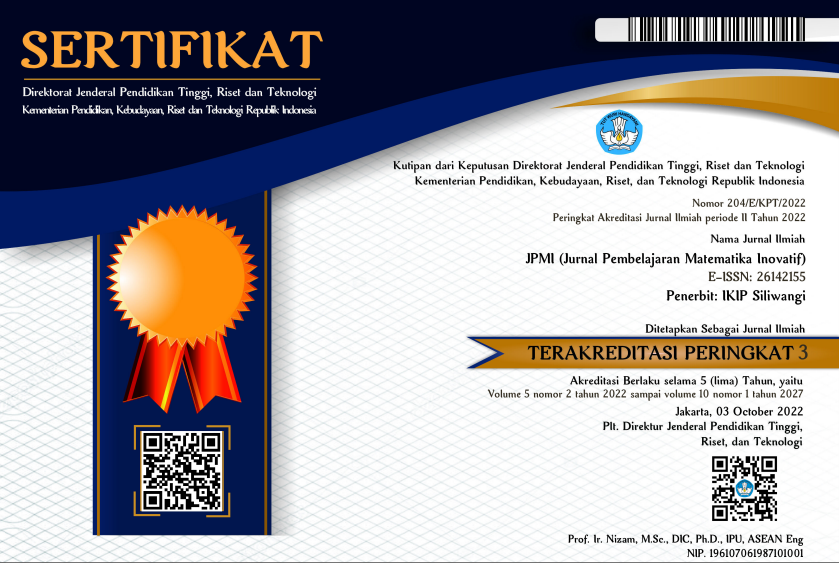ANALISIS KESALAHAN SISWA DALAM MENYELESAIKAN MASALAH MATEMATIKA DENGAN MENGGUNAKAN PROSEDUR POLYA
DOI:
https://doi.org/10.22460/jpmi.v4i4.p749-754Keywords:
Error analysis, Polya's completion stepsAbstract
References
Departemen Pendidikan dan Kebudayaan. (2006). Peraturan Menteri Pendidikan Nasional Republik Indonesia Nomor 22 Tahun 2006 Tentang Standar Isi untuk Satuan Pendidikan Dasar dan Menengah. Jakarta: Depdikbud.
Is, W. (1998). Pssm. Journal of Equine Veterinary Science, 18(11), 719. https://doi.org/10.1016/s0737-0806(98)80482-6
Jana, P. (2018). Analisis Kesalahan Mahasiswa Dalam Menyelesaikan Soal Matematika Pada Pokok Bahasan Vektor. Jurnal Mercumatika : Jurnal Penelitian Matematika Dan Pendidikan Matematika, 2(2), 8. https://doi.org/10.26486/jm.v2i2.398
Kristofora, M., & Sujadi, A. A. (2017). Analisis Kesalahan Dalam Menyelesaikan Masalah Matematika Dengan Menggunakan Langkah Polya Siswa Kelas VII Smp. Prisma, 6(1), 9–16. https://doi.org/10.35194/jp.v6i1.24
Lestari, K. E., & Yudhanegara, M. R. (2017). Penelitian Pendidikan Matematika. Bandung: PT Refika Aditama.
Nuraidah, S., Sarifah, F. S. D., Riajanto, M. L. E. J., & Maya, R. (2018). Analisis Kemampuan Koneksi Matematis Siswa Mts Negeri Di Bandung Barat Pada Materi Segiempat Dan Segitiga. JPMI (Jurnal Pembelajaran Matematika Inovatif), 1(4), 547. https://doi.org/10.22460/jpmi.v1i4.p547-558
Polya, G. (1978). How to solve it: a new aspect of mathematical method second edition. In The Mathematical Gazette (Vol. 30, p. 181). http://www.jstor.org/stable/3609122?origin=crossref
Sugiyono. (2010). Metode Penelitian Kuantitatif, Kualitatif, dan R &D. Bandung: Alfabeta.
Qomariyah, N. (2016). Profil Pemahaman Siswa Sma Dalam Memecahkan Masalah Persamaan Kuadratditinjau Dari Perbedaan Kepribadian Extrovert Dan Introvert. APOTEMA : Jurnal Program Studi Pendidikan Matematika, 2(1), 87–95. https://doi.org/10.31597/ja.v2i1.135
Rofi’ah, N., Ansori, H., & Mawaddah, S. (2019). Analisis Kesalahan Siswa Dalam Menyelesaikan Soal Cerita Matematika Berdasarkan Langkah Penyelesaian Polya. EDU-MAT: Jurnal Pendidikan Matematika, 7(2), 120. https://doi.org/10.20527/edumat.v7i2.7379
Widodo, S. A. (2013). Analisis Kesalahan Dalam Pemecahan Masalah Divergensi Tipe Membuktikan Pada Mahasiswa Matematika. Jurnal Pendidikan Dan Pengajaran, 46(2), 106–113. dodok_chakep@yahoo.com.

















